
The sponge brittle star, Ophiothrix suensonii.
There are numerous sorts of marine creatures in the Phylum Echinodermata, ranging from sea biscuits, to starfishes, to feather stars, to sea cucumbers, all of which belong to one of five extant classes within the phylum. This month we’ll take a look at the members of just one of these classes though, specifically the brittle stars, serpent stars, and basket stars. All of these belong to the Class Ophiuroidea, and some of them are regular offerings, while some are frequent hitchhikers that end up in our aquariums unintentionally.
Many ophiuroids may look superficially like starfishes, which are in the Class Asteroidea, but the ophiuroids are a different bunch of echinoderms for a number of reasons. So, I’ll go over some of the things that unite all these creatures, why the ophiuroids are in a class of their own, and then some information about keeping them in aquariums.
Echinoderm Basics
To get started, let’s run through some echinoderm basics. As I said, there are all sorts of echinoderms, and many of them look nothing alike at all. However, if you take a closer look at them, a few physical features that are characteristic of the group become obvious.
First, their bodies/body parts are arranged around a central axis. Whether or not they have arms (like a starfish), they still usually have a round or nearly round body, with parts radiating from its center. This is called radial symmetry, and it’s the same body plan that cnidarians (corals, anemones, jellyfish, etc.) are built on. Echinoderms and cnidarians both have a centrally located mouth and a round(ed) body, and many have numerous arms/tentacles radiating from the center. However, similarities between members of the Phylum Echinodermata and the Phylum Cnidaria end there for the most part.
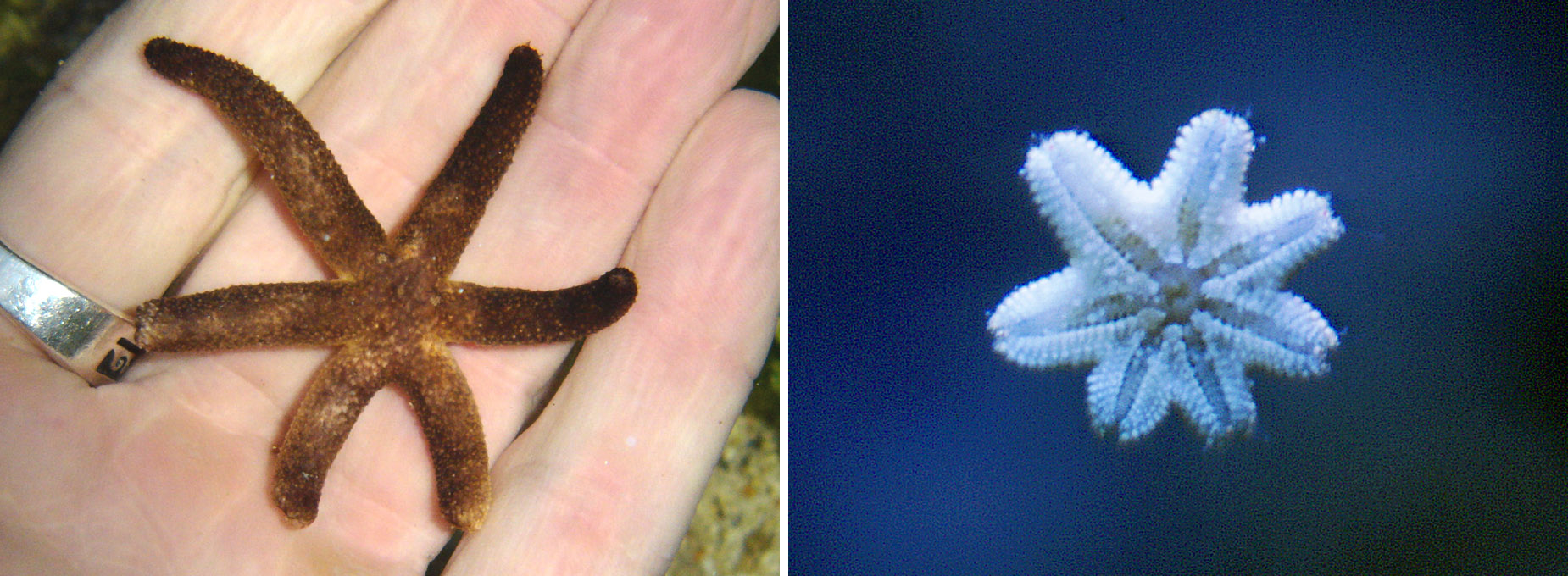
While almost all echinoderms have five-fold radial symmetry, there are exceptions like these asteroids with 6 and 7 arms.
An echinoderm’s radial body can be divided into five roughly equal parts, or a multiple of five, while a cnidarian’s can generally be divided into six or eight, or a multiple of six or eight. To be more specific, the echinoderms are properly said to have penta-radial symmetry rather than just radial, since their parts come in fives. However, you may come across a few exceptions to this five-fold plan on occasion. For unknown reasons, there are occasional sorts of starfishes that have six or seven arms, or some other non-five number, but these are the oddballs.
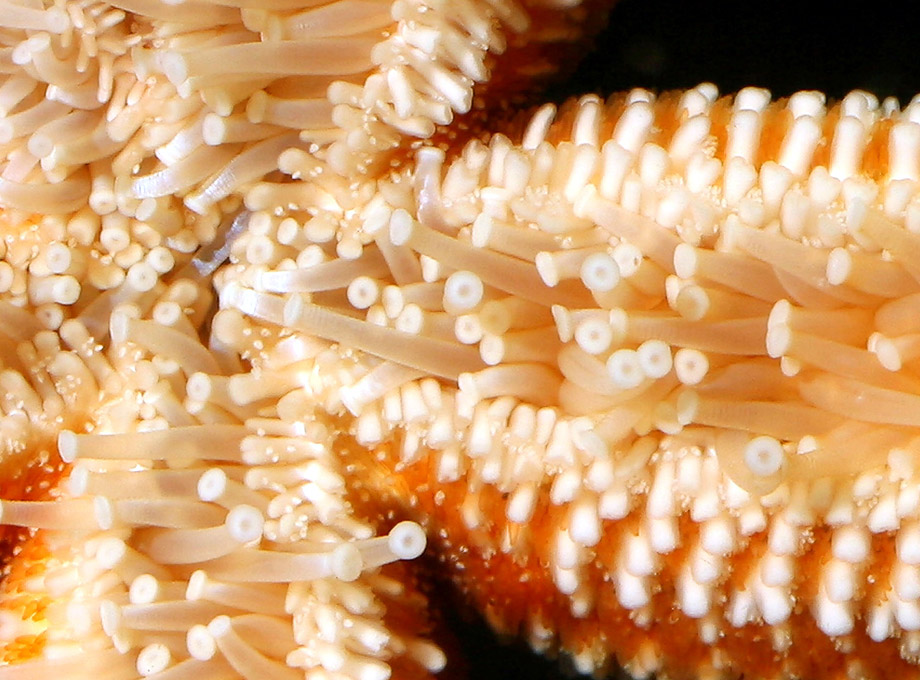
When looking at the underside of an asteroid, the sucker-tipped tube feet, which are a distinct part of its water vascular system, are easy to see.
Moving on, all echinoderms also have a unique water-vascular system, which is complex system of muscles, canals, pouches, bladders, tubes, and suckers that allows them to move about and/or to feed. It also acts as a circulatory system, as these animals lack gills, blood, and a heart.1 If you’ve ever looked at a starfish up close and noticed the rows of little sucker-feet on their undersides, then you’ve already seen part of this system yourself. They have hundreds of suction cup-tipped “tube feet” that emerge from grooves in their undersides, which can be used for both locomotion and food collection. To the contrary, the same sorts of tube feet emerge from the arms of ophiuroids and are used for food collection, but lack sucker-tips, and are not used for locomotion. More on that in a moment, though.
Lastly, echinoderms also have a skeleton of some sort, which is composed of the mineral calcite (CaCO3), and is covered by an epidermis (outer skin). In the case of starfishes and all of the ophiuroids, this calcitic skeleton is composed of numerous individual plates called ossicles, which are held together by special connective tissues that can be made very soft or very firm. This arrangement allows them to be very flexible or extremely tough when they stiffen their bodies in a defensive manner. Other echinoderms, such as urchins and sand dollars also have a skeleton made of plates, but they’re fused together to form a shell, which is properly called a test. If you should look closely at a dead urchin’s test you’d see that the whole thing is comprised of individual plates that are melded together by the same type of suture joints that you’d find holding the bones of a human skull together. Still, in other types of echinoderms like the sea cucumbers, the skeleton is rudimentary, and is nothing more that a number of tiny, oddly-shaped calcitic plates which are embedded in their thick skin of connective tissue.
Asteroids and Ophiuroids
So, with several similarities covered, now it’s time to explain why starfishes and ophiuroids are in separate classes. Most ophiuroids may indeed look like starfishes at first, but there are actually several fundamental differences between them. First, ophiuroids have long, thin arms that are clearly distinct from their organ-containing body, which is typically rather small and somewhat flat. Conversely, an asteroid’s body isn’t distinct and there’s no clear line where the body ends and the arms start. The ophiuroids are also restricted to having only five arms, which are used for feeding and for locomotion. And, in contrast to the asteroids, ophiuroids don’t use their tube feet on the underside of their arms to slowly move around, but crawl around using the arms themselves (although there are a handful of exceptions1). This gives them considerably more speed than asteroids, and some can move surprisingly quickly.
https://www.youtube.com/watch?v=faMbUcTcDUE
Many asteroids feed by turning their stomach inside out and sticking it out of their mouth, which works very well for those that eat clams in particular. They only have to use their sucker-tipped tube feet to pull a clam’s shell open just a bit and then stuff their stomach inside the shell to finish the job. However, the ophiuroids lack an eversible stomach, and thus cannot eat clams (at least not in the same way), or many other items that asteroids can.
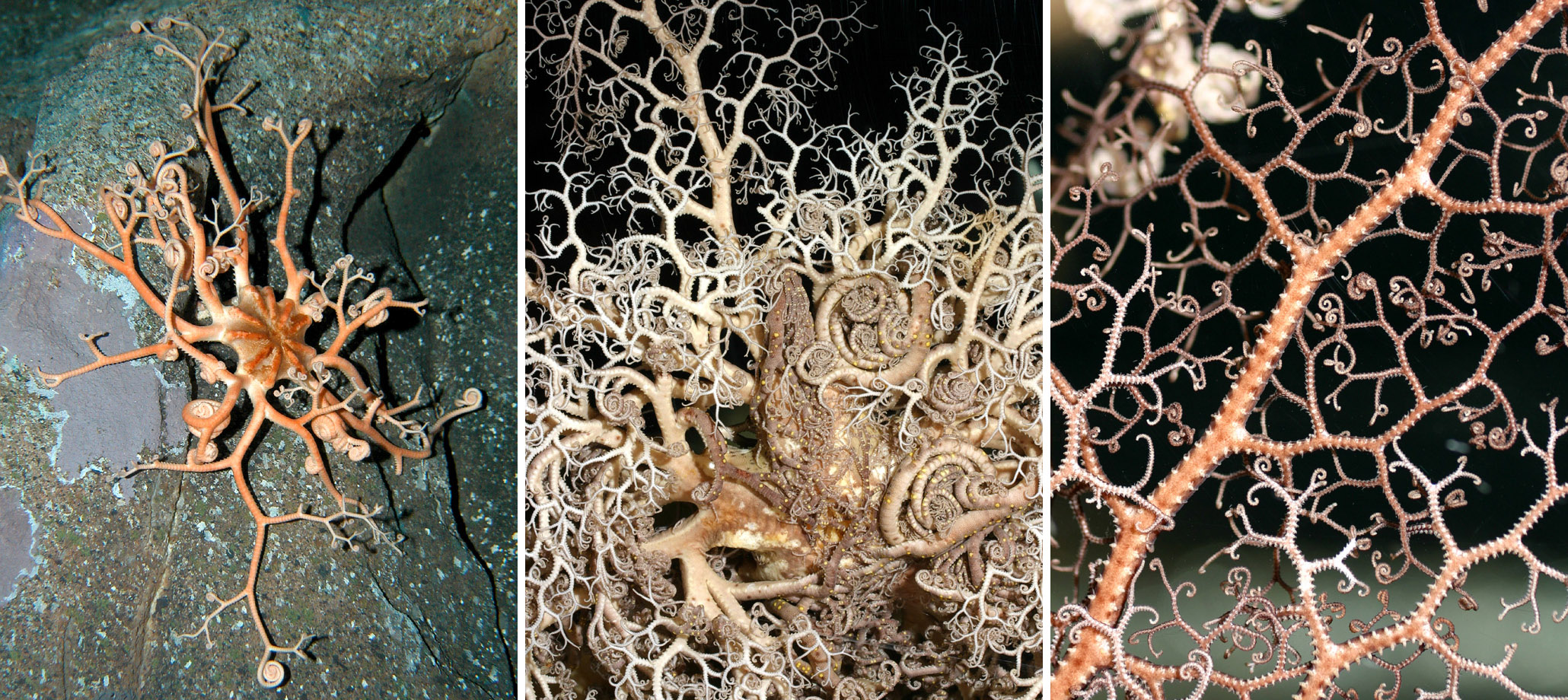
The basket stars are quite unique, as they typically roll up into a fist-size ball during the day and extend their highly-branched arms at night to feed primarily on large zooplankton.
Still, many are successful scavengers and predators that eat a variety of worms, snails, and crustaceans. Some can even use their arms to hold their body off the bottom while they sit and wait for a small fish or other prey animal to swim or crawl in under it. The trap is then sprung and the arms close down and quickly move the body downward onto the prey. The victim thus ends up under the mouth where it is consumed. Others are detritivores that move around over the bottom picking up bits of fish wastes and such, while some burrow through the sediment, extracting what they can.
The basket stars are quite unique though, as they’re suspension feeders that open their arms into the current and snare anything that bumps into one of them. Anything from large zooplankton to small fishes can be grabbed this way, and then passed to the mouth and eaten. Certainly different from any asteroids.
https://www.youtube.com/watch?v=bJ3yXJGIo4Y
Now, within the Class Ophiuroidea itself, for the most part it’s pretty easy to tell the three basic types apart. Many brittle and serpent stars may initially appear to be very similar, but the outwardly visible difference in the two is the general lack of any sorts of projections from the arms of a serpent star. The arms of brittle stars are much fancier and are typically covered with lots of spines, spikes, and/or clubs of various sorts and sizes, while those of a serpent star are relatively smooth and are typically unornamented, looking something like the body of a snake.
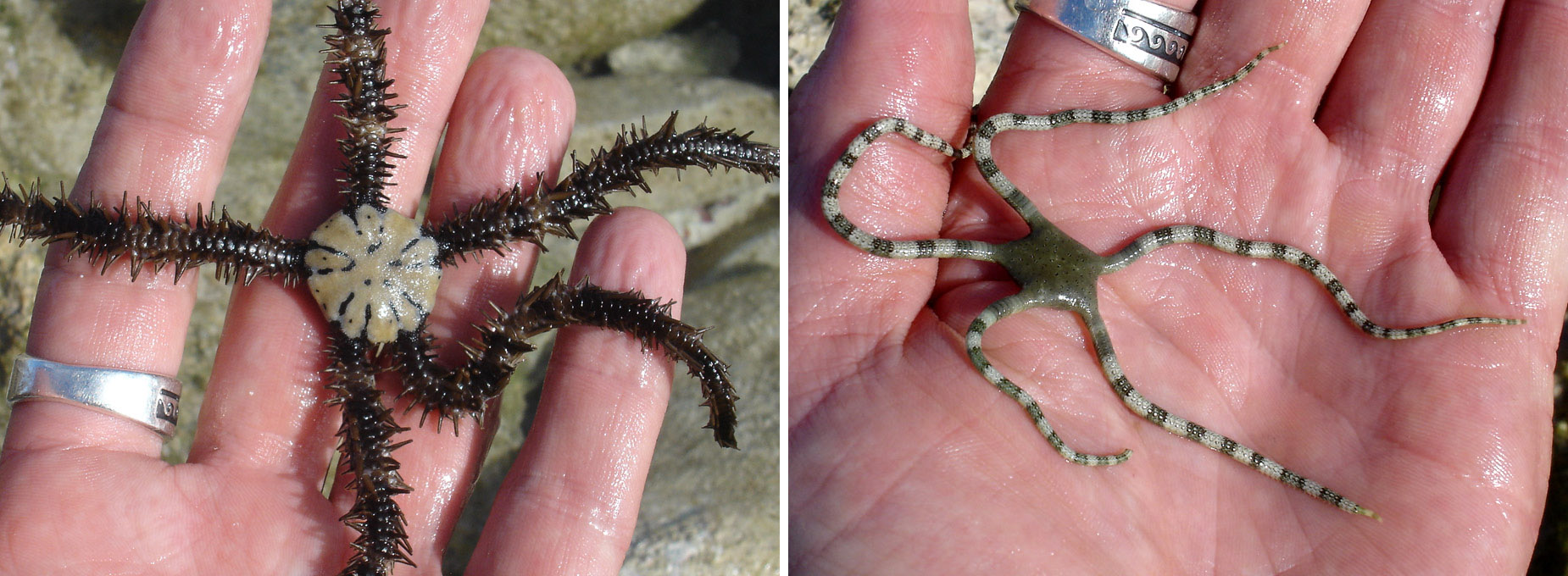
Ophiuroids (other than basket stars) that have relatively fancy arms are typically called brittle stars (L), while those that have relatively smooth arms are often called serpent stars (R).
This division of brittle stars and serpent stars is actually a non-biological one though, and is not based on real taxonomic differences between the two groups. It’s only a division based on general appearance, as some hobbyists, divers, etc. may call various ophiuroids either brittle or serpent stars, while other folks may just call them all brittle stars regardless of what they look like. So, don’t get confused if you see or hear it some other way. The fact is, there are actually several ophiuroids that look to be in between, with smooth discs and just a row or two of relatively small projections coming off their arms. However, basket stars have five arms that are exceptionally long and thin and are branched at their base and then branched, and branched, and branched, and branched from there.
In the Aquarium
Okay, let’s get to some more specific info about keeping various ophiuroids (or not keeping them) in aquariums. There are about 2,000 species of ophiuroids, making the Class Ophiuroidea the largest of the five, and some species or another inhabits essentially all marine habitats.2,3 So, I can’t really go into much detail about so many kinds, as their sizes, lifestyles, diets, etc. are highly variable. However, I can give you some general information about them as a whole, and some more specific info about a few types commonly seen for sale and those that frequently enter our aquariums as hitchhikers.
To start, as mentioned above, various ophiuroids are carnivores, scavengers, deposit feeders, or suspension feeders. Most of them actually feed in several ways, yet they typically have a preference/primary means of eating.1 This flexibility means that it’s typically pretty easy to keep most of them alive.

Small to medium-size brittle/serpent stars, like Ophiocoma echinata, can typically be kept in reef aquariums without problems.
As best as I can tell, you can feed brittle and serpent stars any sort of fish food, such as bits of fish, clam, or shrimp meat, various sinking pellet foods, and even flake food, and they’ll usually gobble it up quickly. I have two in one of my aquariums that stay hidden in the rockwork for the most part, but they’ll catch flake food with their arms when it drifts close enough to them. All I typically see is some skinny arms flailing between some pieces of rock near the bottom, and every once in a while they snag something.
Anyway, aside from occasionally catching some fish foods, even these surprisingly large specimens that are several inches across can apparently find enough leftover fish food and edible detritus to keep themselves alive. And, to the best of my knowledge they’ve never bothered any of my other livestock, and neither has any other small to medium-size brittle/serpent star I’ve ever had.
However, I have read and heard that some of the commonly-offered small to medium brittle/serpent stars will dine on one particular type of invertebrate often found in reef aquariums, being feather duster tube worms like Bispira sp. Apparently some species will indeed extract such worms from their tubes and eat them.4 So, be mindful of this if you have, and plan on keeping, any of these in your aquarium.
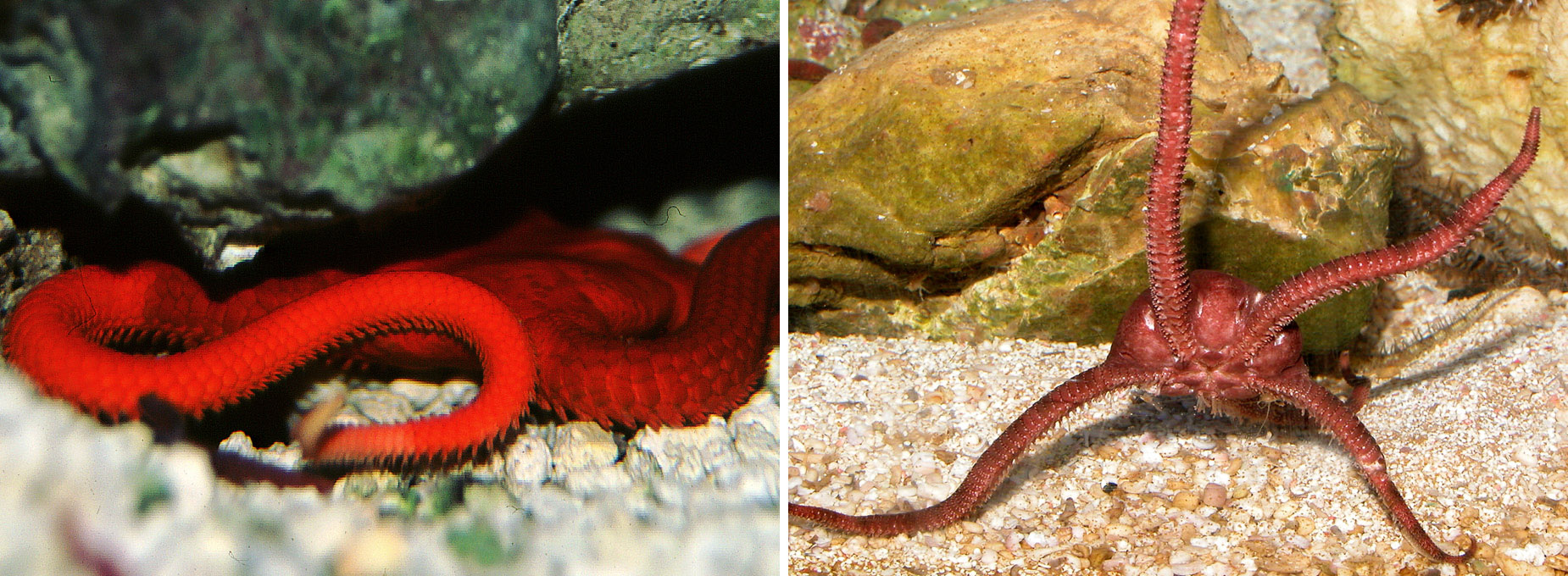
The red serpent star, Ophioderma squamosissimus, is an example of a large serpent star that will feed on many other motile invertebrates and small fishes, and are best left out of reef aquariums.
Larger brittle/serpent stars, on the other hand, can cause problems at times. Many are primarily detritivores, like most brittle stars, but some are carnivores, and some of the large species will eat everything from small fishes and shrimps to hermit crabs.4 I described their primary means of catching fishes above, like a trap, but many other prey items are simply grabbed by the arms and ingested.
I had a very large red serpent star, Ophioderma squamosissimus, that would smell fish food I put in one of my non-reef tanks and would immediately come out from underneath the (dead) coral head it called home, stand on two arms, and prop itself up on the front pane of the tank waving the rest of its arms for food. Dropping in a few sinking shrimp pellets was all it took to keep it healthy and growing, but then I did come up with a missing damsel every once in a while, and was left to wonder if it had caught them.
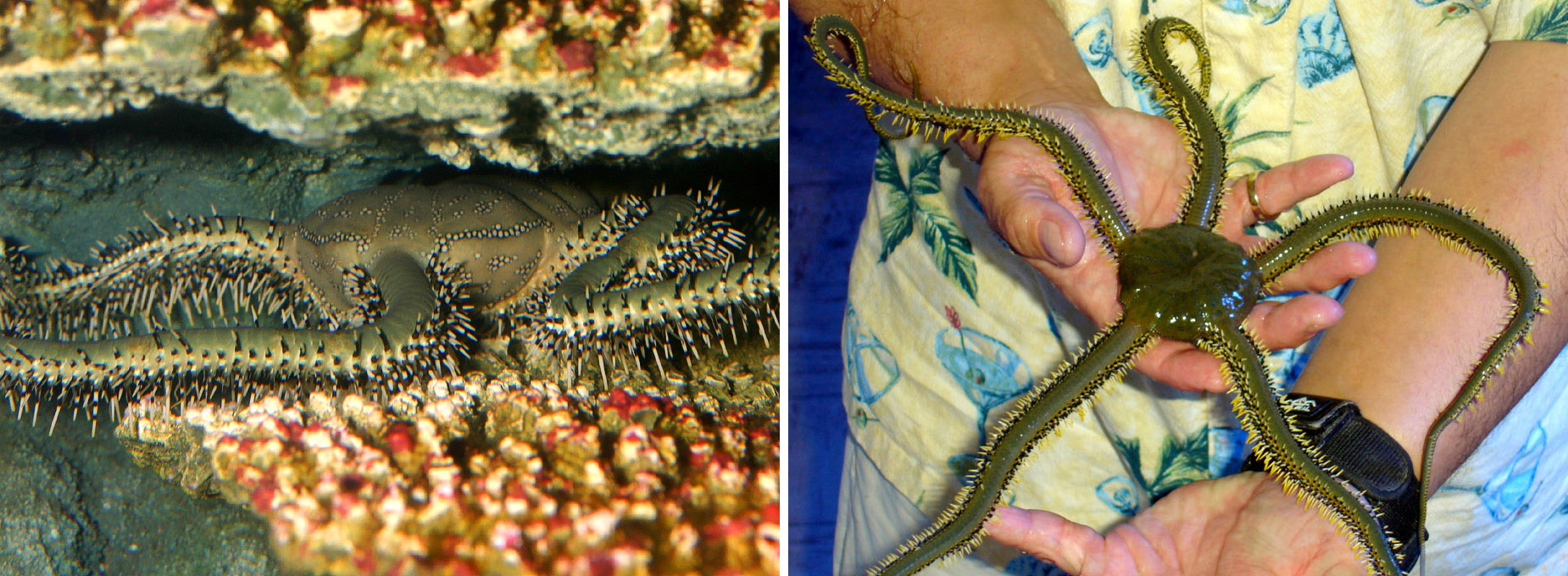
The green brittle star, Ophiarachna incrassata, is one of the most common offerings in the hobby, but it can get awfully big. I’d also refrain from adding something of this size to a reef aquarium, as they may knock over anything they crawl on. Of course, they’ll feed on many motile invertebrates and small fishes, too.
I definitely wouldn’t have put it in a reef aquarium for fear that if nothing else, it would bowl over anything and everything in the tank that wasn’t too heavy for it to move. Mine was about a foot across and faster than you might think, and some others, such as the commonly-offered green brittle star, Ophiarachna incrassata, can get even larger, sometimes growing to over a foot and a half across.5 So, be mindful of potential sizes and diets before adding any of the larger species to an aquarium.
https://www.youtube.com/watch?v=X39yNKtVbX0

There are numerous species of small brittle stars, like Ophiothrix spp., that can enter our aquariums as hitchhikers on corals and such. These are harmless, and do not require any special care.
Aside from these, while you won’t likely see them for sale, there are numerous species of relatively tiny brittle stars that live in rocks, sponges, and/or corals, which typically have very thin arms that are quite fuzzy looking. These are the common hitchhikers I mentioned above, which can get into your aquarium when live rock, corals, etc. are added to it. So, you might find one (or lots of them) living in your aquarium at some time, but these are nothing to worry about. I’ve never seen any of these do any harm to whatever they were living in/on, and they don’t require any special feeding. These can fend for themselves quite well, and oftentimes reproduce in captivity, as well.
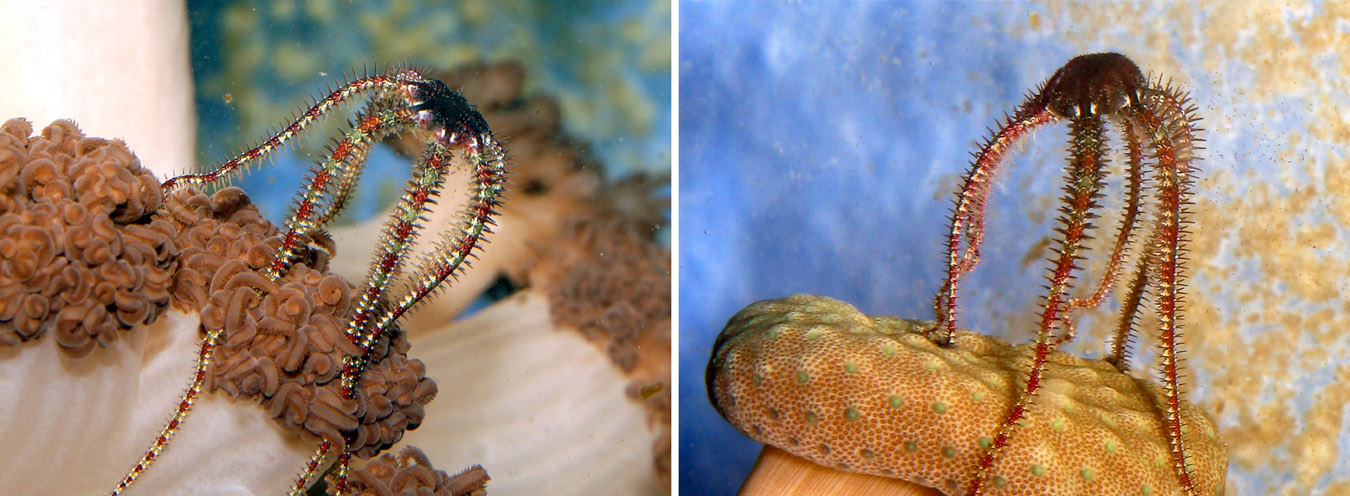
I didn’t catch a cloud of gametes coming from these, but here are a couple of small brittle stars perched atop corals and spawning.
It might sound odd that invertebrates such as these will often reproduce in aquariums, but I’ve seen it happen on many occasions. Most have separate sexes, but many are hermaphroditic, some being simultaneous hermaphrodites, and they sometimes spawn in aquariums, which is often a tank-wide event.1,6 I’ve seen dozens of them simultaneously emerge from their hiding places in rocks and such, climb up the tallest thing they can find, and then start releasing tiny puffs of gametes into the water. Some can also brood their young, which are kept in pouches in their bodies and released as miniscule juveniles from the parent.1,6 Many species can also reproduce via fission by splitting off parts of their own bodies. Echinoderms in general have the ability to regenerate lost or damaged body parts, and this ability also allows them to produce more of themselves in an asexual manner.1,7 So, don’t be surprised if you start with one brittle star and end up with many. I’m sure I have several hundred of the small ones in my large reef aquarium, despite never adding one intentionally.
With all that said, it’s the basket stars that all aquarists should best stay away from. Basket stars catch relatively large zooplankton, including crustaceans and polychaete worms, and there typically isn’t much (or any) appropriate zooplankton available in aquariums.1 So, they are not suited for life in captivity. While I’ve seen them for sale from time to time, after doing quite a lot of searching I wasn’t able to find a single case of a hobbyist keeping one of any size alive for more than a few months. Moving on…
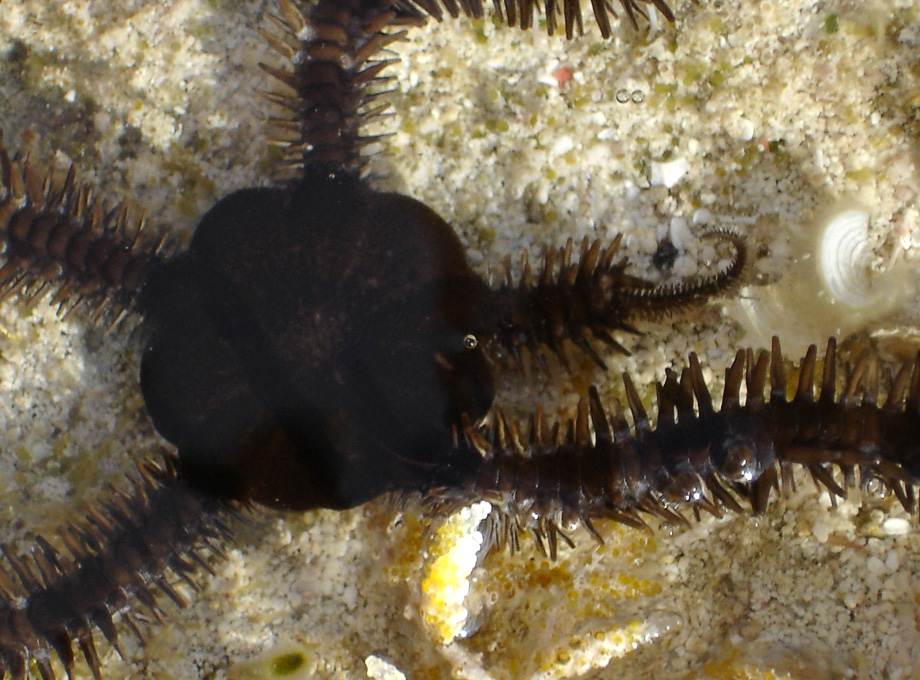
Echinoderms can have impressive regenerative powers. If you should find a specimen that has lost an arm, but appears to be re-growing it – don’t worry. It’ll grow back to full size over time under good aquarium conditions..
Lastly, there are a couple of other things to know about brittle/serpent stars before I finish. The first is that you need to be very careful when acclimating any of them. For whatever reason, I’ve found that these are generally quite sensitive with respect to changing conditions, and should be given plenty of time to adjust to your aquarium’s water. A slow drip acclimation is likely the best way to go, and all you need is a small bucket and a piece of airline tubing. Put the specimen in the bucket with the water from the store, and then start a siphon from the tank to the bucket with the tubing. To slow down the flow, just tie a knot in the tubing. Then, let the tank water slowly mix into the store’s water, until you have at least four times as much water in the bucket as you started with (roughly). Then add your specimen to the tank.
Also be sure to look for any sort of white, slimy looking matter on a specimen while shopping. They tend to sort of turn white and mushy when they’re in bad health, so be on the lookout for anything that doesn’t look right. In my experience they very rarely recover once this starts to happen, so pass over a specimen showing any such signs.
However, there is no need to pass on a specimen that has a lost an arm or two, as long as it otherwise appears healthy and is actively growing back the lost arm(s). Arms can be lost during collection, and oftentimes an arm is dropped by the owner as a means of escaping predators similar to the way some lizards can pop off part of their tail for the same purpose. Again, echinoderms as a whole are well-known for their capacity to regenerate lost parts, so as long as there is no sign of decay, and you can see that a new arm is growing back, rest assured that it will continue to grow and the owner will recover as long as conditions are good in its new home.
References
- Rupert, E.E., R.S. Fox, and R.D. Barnes. 2004. Invertebrate Zoology: A Functional Evolutionary Approach: 7th ed. Brooks, Cole, Thomson, Belmont CA. 963pp.
- Brusca, R.C. and Brusca G.J. 2003. Invertebrates. 2nd ed. Sinauer Associates, Sunderland, Massachusetts. 936pp.
- Stöhr, S., T.D. O’Hara, and B. Thuy. 2012. Global diversity of brittle stars (Echinodermata: Ophiuroidea).PLoS ONE: 7(3).
- Fossa, S. and A. Nilsen. 2002. The Modern Coral Reef Aquarium, Volume 4. Birgit Schmettkamp Velag, Bornheim, Germany. 480pp.
- World Register of Marine Species, undated. Ophiarachna incrassata. URL: http://www.marinespecies.org/aphia.php?p=taxdetails&id=213207.
- McGovern, T.M. 2002. Patterns of sexual and asexual reproduction in the brittle star Ophiactis savignyi in the Florida Keys. Marine Ecology Progress Series: 230.
- Mladenov, P.V., R.H. Emson, L.V. Colpit, and I.C. Wilkie. 1983. Asexual reproduction in the West Indian brittle star Ophiocomella ophiactoides (H.L. Clark) (Echinodermata: Ophiuroidea). Journal of Experimental Marine Biology and Ecology: 72(1).



0 Comments